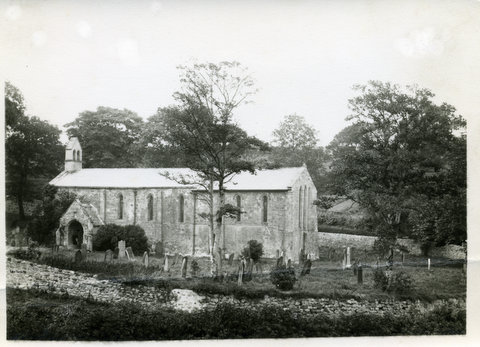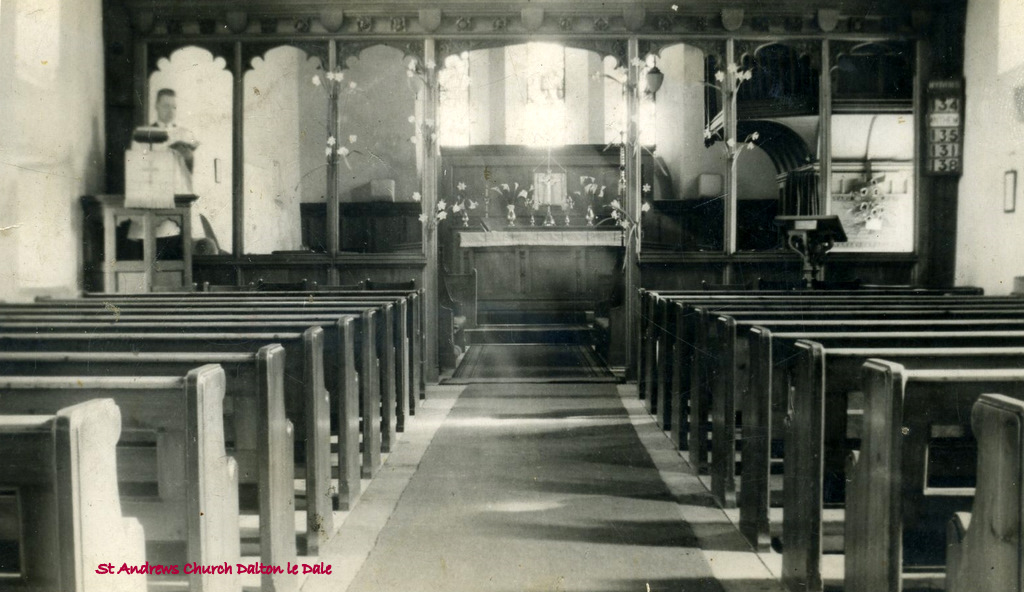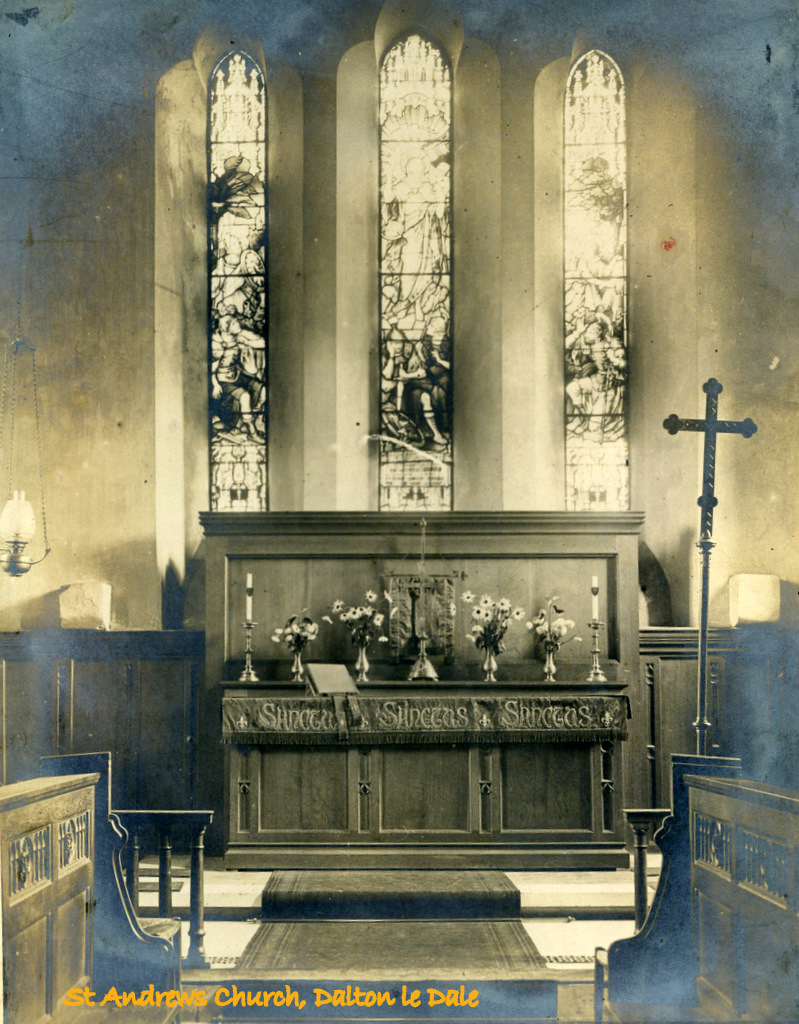
St. Andrews Church - Ancient History
St Andrew’s Church, Dalton le Dale, a possession of Durham Cathedral Priory in the 12th century, has evidence of a late 8th/early 9th century suggesting that it stands on a considerably earlier site. The sub-circular plan of the churchyard also suggests early origins, the site is listed Grade II*.

The church is entered by the South Porch under an obtuse pointed arch. It is evident that the current church was a Norman structure although little now remains except the doorway on the North wall. This entrance with its semi-circular arch and chevron moulding it is the oldest part of the building.
According to ancient documents, in the year 1115, a division had been legalized by ‘solemn composition’ between the church’s Dalton possessions and those of the ‘Lords of Seaham and Dalden’, the agreement being made between the Prior and convent of Durham and Hellas D’Escolland together with his son Galfid
Dalton was restored to the Church at Durham and nearly three centuries later Bishop Richard de Mariso gave St. Andrews to the Convent.
Christian men and women occupied the Dale well before the Norman Conquest and though no doubt by accident, St. Andrews possesses a memorial of these ancient inhabitants of the valley. This memorial is a curious stone built into the South Wall of the building, not far from the West end and approx 11ft-12ft from the ground. This stone bears signs of Saxon workmanship and is possibly a cross shaft or grave stone of Saxon times.

Within the church, by the North wall of the chancel, is the tomb of Sir William Bowes circa [1375] surmounted by a fine figure in full armour. Another effigy to be found within the North Wall is the mutilated figure of a female wearing a nun’s veil, reputed to be that of Lady Collingwood.

Another major feature of the church is the external Anglo Saxon sundial located in the wall above the south porch. With its twisted rope design (similar to the dial in Escomb Church) and inscribed in A-S tides it represented the only method of timekeeping before the introduction of clocks. This is one of only 38 still existing in the country.
An interesting internal feature of the church is the row of raised numerals on the North wall, probably 18th Century. Once used as a sun dial measuring the suns path along raised numerals on the wall opposite a now sealed slot in the middle south wall through which a suns rays beamed to pick out the numerals denoting the time of day.
A tablet above the sun dial, records the Church’s first vicar a Norman, Gilbert de Bellingham in 1180.

The church seems to have underwent a remodeling around 1631 as can be seen by the wall tablet in the nave, were the initials shown those of the church wardens? This information is also evident on the church tenor bell. One of the Churches two entrance doors has long since been ‘sealed up’; this is the Norman arched door way in the North wall, possibly the last time it was opened was during the renovation in 1907. The south doorway being covered since about 1450 with its present porch way.
A feature of St. Andrews are apertures in the north and south, presumed to have been used in serving lepers with Holy Communion by means of a ladle although it may be that, in the absence and later expense of glass the narrow spaces were made to admit light but not bodily intrusion.
As a result of the ever-increasing population (due in the main to the opening of the Murton New Winning coal mine) the centre of parochial life moved from Dalton to Murton. It was recognized that St. Andrews was too small to accommodate the need of the community and on June 1st 1877 a new Parish Church of Dalton le Dale, dedicated to the Holy Trinity was consecrated by the Bishop of Durham and the small church in the Dale became a chapel of ease. Meanwhile the fabric of the old church had begun to show well worn signs of age, which demanded immediate attention.
In 1890 St. Andrews was repaired and subsequently reopened on the September 23rd, by Dr Westcott, Bishop of Durham, this being his first public ceremony following his appointment to office.

Several years later Rev. G.W Anson Firth who came to the parish in 1902 called attention to the disrepair and requirements of the internal fabric.
A committee consisting of Colonel James Gregson, Messrs J.S.G.Pemberton, Rev G.W. Anson Firth.R Williamson, G Roots, Mrs. Hamerton [Treasurer]. An appeal was made to all those interested in the preservation of ecclesiastical architecture for subscriptions towards the fund.
The Fund raised more than £1,474-7s-6d. Contributions were made by Mrs. George Gregson £400, Ecclesiastical Commissioners £200, Colonel Gregson £100, Marquis of Londonderry £10, J.S.G. Pemberton Esq, 10 Guineas.
The work undertaken by Messrs G. Gradon and Sons of Durham included the; rebuilding of the South porch, the ceiling of the nave was removed and paneled, with the slates of the roof re-laid on a wooden lining. Part of the East wall of the chancel rebuilt and a strong buttress reared against the Southeast corner. The East wall was tied by iron rods with walls being stripped and re-plastered. The chancel arch was removed and replaced by a carved beam, which marks the junction between the nave and chancel. The stained glass windows in the east wall were renewed, containing dedications to the Gregson family. Together with other renovations the total cost was well over £1500. Two features were discovered during this renovation, one being traces of a low arched recess in the North wall of the nave [possibly for a recumbent effigy] and the other an aumbrey in the South wall.

In 1907 St. Andrews re opened with the Murton Church Choir under the direction of Mr. G Watkin who began the processional hymn from the church gates.
Robed Clergy included The Lord Bishop, Reverend G W Anson Firth, Rev R H Yeld, Rev H E Powell and Rev Jas Colling. Others present included Colonel, Mrs. and Miss Gregson of Burdon, The Mayor of Durham. Following the service and during tea The Murton Colliery Prize Band played a selection of music including the test piece for the Crystal Palace.
There are fourteen windows in the Church thirteen of them being of the lancet type. Ten of which are of stained glass, nine of them dedicated to the memories of various members of the Gregson family. The latest windows include a year 2000 millennium window and in 2014 a window dedicated to the late Mrs. A Seth. The lectern and large bible are gifts presented by the Gregson family. In the sanctuary stands an oak chair in the memory of John and Hannah Hall given by their daughters Margaret Hoare and Hannah Davidson.
St. Andrews boasts an organ built by Harrisons of Durham [1913]. Ten years after its installation, a tremolo stop was incorporated, the gift of Sir John Priestman.
Recent improvements include the installation of a disabled toilet, a gallery on the west end of the nave and new kitchen facilities. This work was completed in 2011 and allows the church to accommodate more social activities within the community.
A family vault lies below the floor underneath the gallery and contains the coffin of John Gregson who died in 1840; this together with other commemorations reflects the love and affection held by notable families for this ancient and picturesque church.
Regular services are still being held in the church, carrying on the Christian ethos from ancient times.